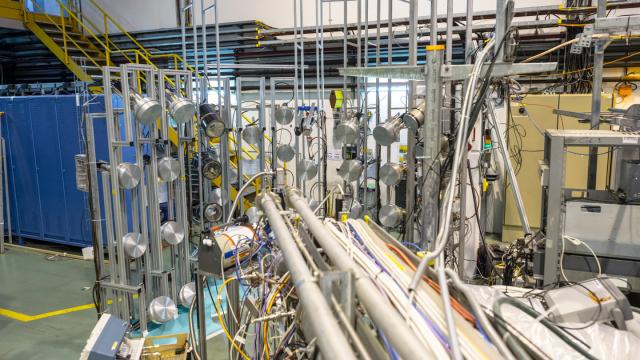The antimatter of science fiction vastly differs from the real-life antimatter of particle physics. The former powers spaceships or bombs, while the latter is just another particle that physicists study, one that happens to be the mirror image with the opposite charge of the more familiar particles.
The ISOLDE experiment will receive the portable antimatter (Image: CERN)
Normally, scientists produce antimatter in the lab, where it stays put in an experimental apparatus for further study. But now, researchers are planning on transporting it for the first time from one lab to another in a truck for research. Elizabeth Gibney reports for Nature:
In a project that began last month, researchers will transport antimatter by truck and then use it to study the strange behaviour of rare radioactive nuclei. The work aims to provide a better understanding of fundamental processes inside atomic nuclei and to help astrophysicists to learn about the interiors of neutron stars, which contain the densest form of matter in the Universe.
This might sound crazy or dangerous or whatever, but it isn’t, I promise! CERN in Geneva, Switzerland has a facility called the Antiproton Decelerator, also called the antimatter factory, that produces the antimatter counterpart to the proton. CERN also has a nuclear physics experiment, called ISOLDE, that creates a beam of radioactive atomic nuclei, the crunchy centre of atoms. Radioactive nuclei typically have way more neutrons, the neutral subatomic particle, than protons, the positive subatomic particle that determines an atom’s identity.
There’s a lot that scientists don’t know about these radioactive nuclei – where do all of the extra neutrons go? Do they form a sort of neutron skin around the surface, or do they live in a neutron halo further out from the rest of the particles? It’s possible to probe this structure by colliding the nuclei with antiprotons and recording what happens. But radioactive particles are short-lived – they lose neutrons and protons in chunks, or their neutrons spit out electrons and turn into protons.
“So one has to bring the antiprotons to where the nuclei are,” Alexandre Obertelli, spokesperson of the endeavour called PUMA: AntiProton (P) – Unstable Matter Annihilation from TU Darmstadt in Germany, told Gizmodo. But it isn’t just a few antiprotons they have to bring. The researchers will need to create a cloud with a billion antiprotons that can last for several weeks or more, then store it in a vacuum and bring it on the short journey from the Antiproton Decelerator to ISOLDE.
I asked whether there were any safety concerns about toting around all of this antimatter – after all, when matter particles meet antimatter particles, they annihilate one another in a burst of energy. Obertelli assured me there’s nothing to worry about. A billion really isn’t that many particles when you think about the fact that there are approximately 602 sextillion protons in a gram of hydrogen. That’s a hundred trillion times more than the amount of antiprotons the researchers will be transporting. “The energy released by the sudden annihilation of a billion antiprotons is less than a joule. It would correspond to the necessary energy to lift an apple by 20 centimeters” Obertelli told me. The project’s safety concerns have more to do with shielding researchers from any potential secondary radiation.
The Nature article says that the containment system should be ready by 2022, and if things work out, they might be able to transport antimatter even further. CERN antimatter physicist Chloé Malbrunot told Gibney that the project was challenging but feasible.
Yes, waiter? I’ll take a billion antiparticles to go, please.
[via Nature]
